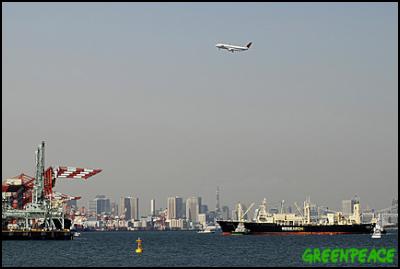Whaler's factory ship docks amid criticism
Whaler's factory ship docks amid scientific criticism

Tokyo, Japan — The Nisshin Maru arrived in Tokyo Bay today. Its time in the Southern Ocean Whale Sanctuary was cut short by a tragic fire, which claimed the life of one crewmember and threatened the Antarctic environment. Over the course of this past season 505 minke and three endangered fin whales were killed.
Recently an International Whaling Commission
(IWC) review of Japan's so-called whaling programme showed
that their "research" has learned virtually nothing about
whale populations in the Southern Oceans despite 18 years of
hunting.
Scientific review
Japan justifies its whale hunts by issuing "scientific" whaling permits. Its original Antarctic whaling program (called JARPA) ran from late in 1987 through early 2005 - despite repeated requests by the IWC to call it off.
Late last year 56 scientists (including 29 from Japan) held a workshop under the auspices of the International Whaling Commission's Scientific Committee to review JARPA. The goal of this workshop was simply to evaluate how well the objectives of JARPA had been met.
Research a failure - minke whales
'immortal'?
The reviewing scientists recently issued conclusion is that none of JARPA's four objectives, which involved harpooning 6,778 whales, was reached.
A major objective was to establish the natural mortality rate for minke whales. The results?
"It was noted that the confidence intervals around the estimates of natural mortality estimated from the JARPA data alone spanned such a wide range that the parameter remains effectively unknown at present." and "in particular, even a zero value was not excluded by the analysis."
So, their bogus research programme could not establish reliable mortality rates for minke whales and the statistical analysis cannot even rule out a zero mortality rate - which would make minke whales immortal!
Attempts to determine if whale populations were increasing or decreasing also failed.
The workshop noted that, "the current confidence intervals for the estimates of trend are relatively wide. These results are, therefore, consistent with a substantial decline, a substantial increase, or approximate stability in minke whale abundance in these geographic areas over the period of JARPA."
As Junichi Sato, Greenpeace Japan Whale Campaign Coordinator put it, "The Japanese people have spent 18 years and millions of yen funding a so-called research programme that has produced nothing of substance."
What next for the
factory ship?
The whalers are rushing to repair their factory ship in time for a North Pacific whale hunt later this year. And next December, the whalers plan to hunt up to 935 minke whales, 50 endangered fin whales and 50 threatened humpback whales off the coast of Antarctica.
Instead, the Nisshin Maru should be retired, and Japan's thinly-veiled commercial whaling programme ended. The government should also give a full public account of the cause of the fire.
Our own ship, the Esperanza, will arrive in Japan next week. We have invited both whalers and government officials to meet on board.
ENDS


 Gary M. Feinman, IMI: Archaeology Can Now Tell Us How People Have Muffled And Challenged Economic Inequality Across History
Gary M. Feinman, IMI: Archaeology Can Now Tell Us How People Have Muffled And Challenged Economic Inequality Across History CNS: Will All Children Be Born Free Of HIV, Syphilis And Hepatitis-B By 2030?
CNS: Will All Children Be Born Free Of HIV, Syphilis And Hepatitis-B By 2030? Save The Children: Sudan - One Child Every 10 Seconds Forced To Flee Their Home Since Conflict Began Two Years Ago
Save The Children: Sudan - One Child Every 10 Seconds Forced To Flee Their Home Since Conflict Began Two Years Ago People with Disability Australia - PWDA: People With Disability Invisible In Election Debates And Housing Promises
People with Disability Australia - PWDA: People With Disability Invisible In Election Debates And Housing Promises East West Center: NZ Deputy Prime Minister Recounts Longstanding US-NZ Relationship In The Pacific
East West Center: NZ Deputy Prime Minister Recounts Longstanding US-NZ Relationship In The Pacific Global Jews for Palestine: Jewish Organisations' Passover Statement, After 40 Days Of Starvation
Global Jews for Palestine: Jewish Organisations' Passover Statement, After 40 Days Of Starvation